 My sister and brother-in-law, Phyllis and Peter, own a house overlooking a small pond in Western Massachusetts, seen below (those are not false colors, that's what New England looks like in the Fall): 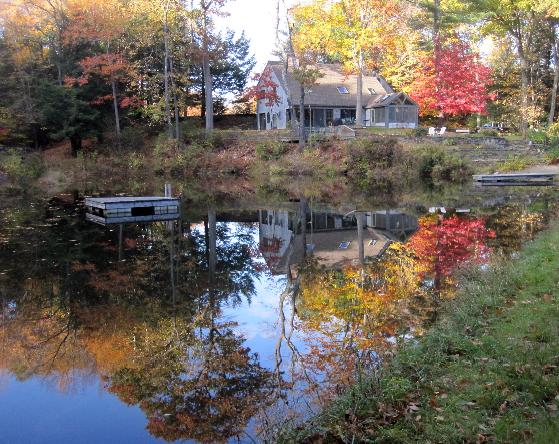 Except there was no pond when the house was built, there was only a small woodland stream. Peter had the vision to see what might be, and placed the house accordingly. But was a pond actually a possibility? After all, you might dig a hole and find that any water poured into it would just disappear into the ground. Was the flow of the stream sufficient? Would the pond hold water? In 1985, an excavator with a lot of experience building ponds took a look at the site. He surveyed the terrain, and then picked up a few handfuls of soil. These he squeezed in his hand. When he opened his fist, the soil remained standing in a firm ball, indicating a high clay content, and not too much sand. Partly on the basis of that sophisticated testing, a substantial investment was sunk into creating the pond, as shown in the pictures which follow. You can click on the next four pictures below to enlarge them, and return with your browser's "Back" button:
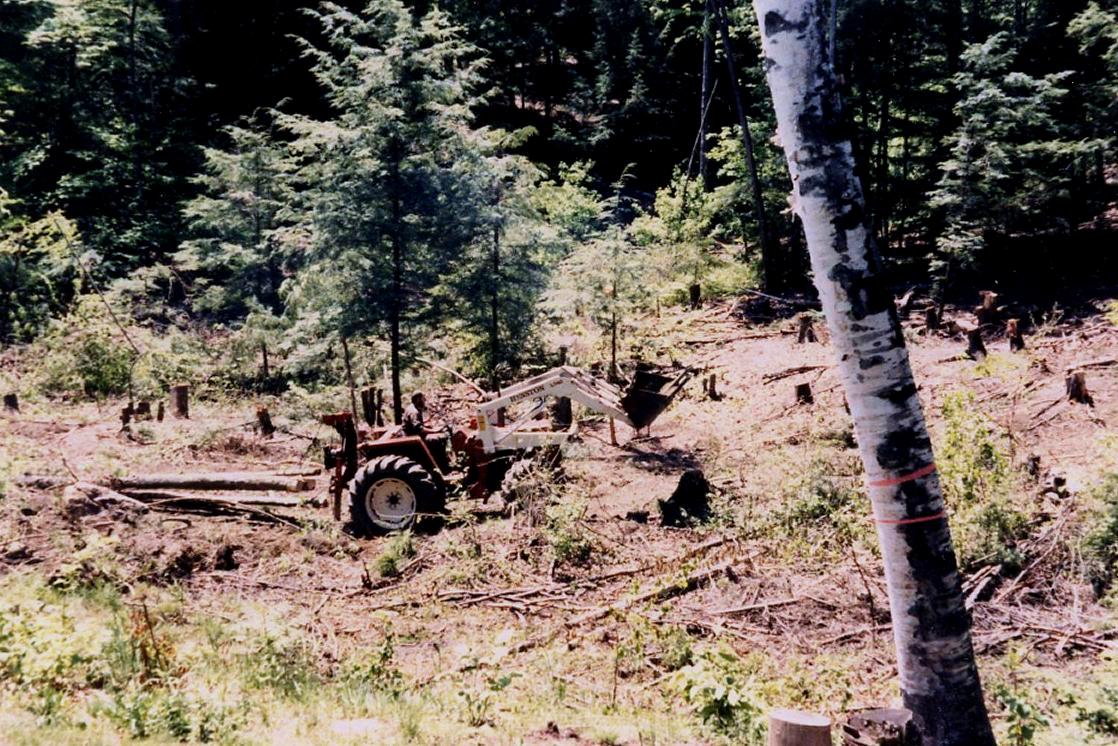 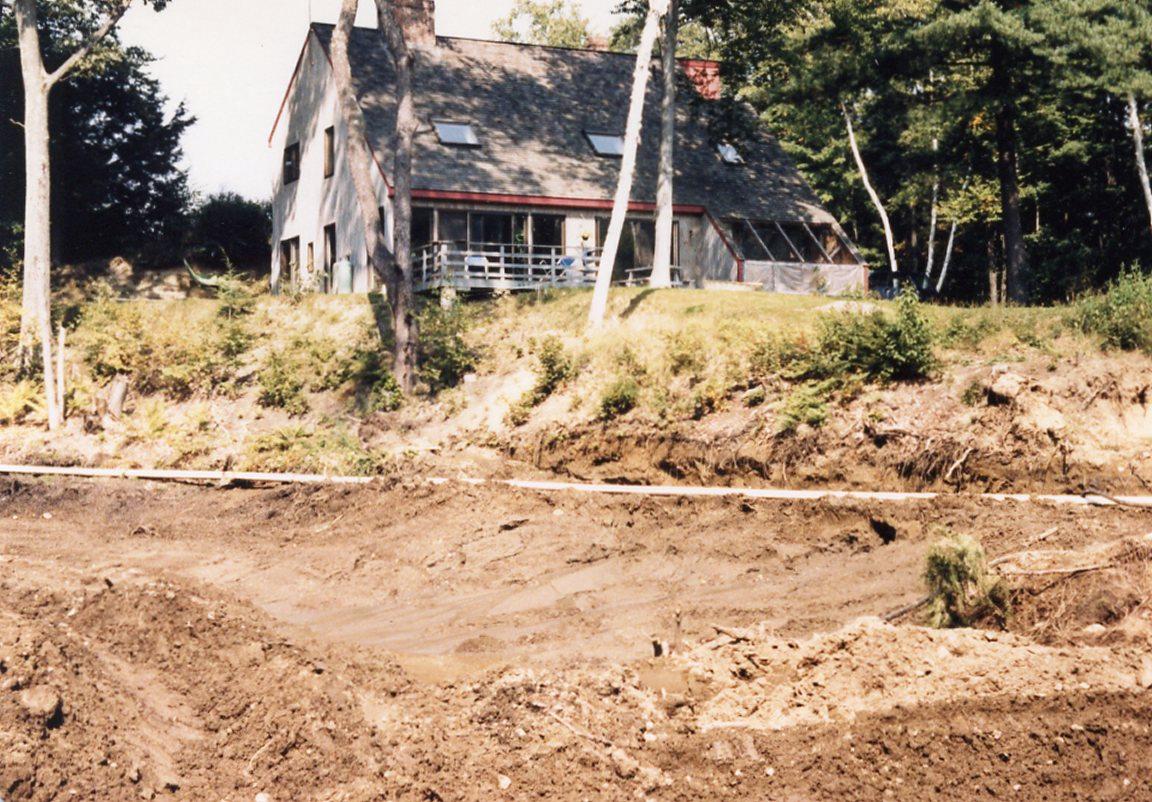 The white line in the photo above is a 4 inch (10 cm) PVC pipe installed to divert the water from the stream, so that the pond area would stay dry during excavation. Coincidentally, it is located at about the height of the ultimate water level. Although the intent had been to finish the pond before the Winter of 1985, they didn't quite make it, so work continued in the Spring of 1986. After an earthen dam had been constructed to hold back the water, a slot was cut into it for placement of a pipe assembly. 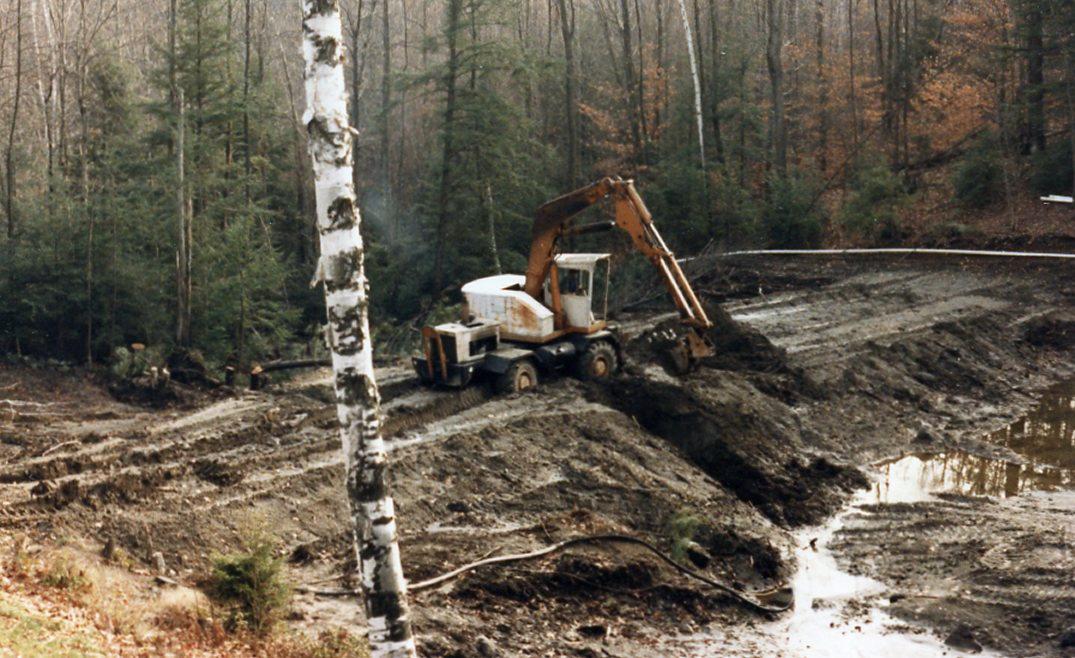 The pipe assembly is an inverted "T", with a 2 foot (61 cm) diameter vertical pipe, an 18 inch (46 cm) diameter horizontal "downstream" pipe to carry the water that drains down the vertical pipe out through the dam, and a 10 inch (25.4 cm) "upstream" pipe. The upstream pipe has a cap on it which can be opened, most effectively by a scuba diver, in order to drain the pond. As I write this in 2012, that's already been done twice since the pond was completed over 26 years ago. That's because silt brought in by the stream needs to be cleaned out periodically.
Which brings me, finally, to my story about the pond. I happened to visit around the time the work was being completed. Water from the stream was pouring into the empty pond, meandering along the bottom of the excavation, and flowing through the open valve into the outflow pipe through the dam. All that remained to be done was to close the cap over the upstream pipe, and let the pond fill up. I looked at the hole that had been dug for the pond, which was about 12,500 square feet in area, or about 0.3 acres (about 1200 square meters). Then I looked at the incoming stream, and it seemed to me that there was not enough water pouring in to maintain a pond of that size. I figured that when the pond was filled, a lot of water would seep into the soil, since soil is porous (unlike, say, a concrete swimming pool). And while some of the pond's bottom is rocky "ledge", a lot of it is not. I proposed to Peter that we might measure the flow, and estimate how long it would take to fill up the pond. Peter came up with a piece of galvanized corrugated steel roofing material, and it was surprisingly easy to shove it entirely under the incoming stream, at a place where there was already a bit of a natural waterfall where the stream entered the excavation. We then stuck a large plastic bucket under the flowing water, and timed how long it took to fill up. Peter thinks that the bucket was probably a 5 gallon bucket that had been used for joint compound. 5 U.S. gallons is about 0.67 cubic feet, about 19 liters. Knowing the volume of the bucket and the time it took to fill, we could easily compute the flow rate, which we did in cubic feet per second. We then went to the far end of the excavation, and put the same bucket under the outflow pipe sticking out of the dam. I was interested in seeing how much water was lost crossing the excavation. I assumed that some of the water would seep into the ground along the way, so that less water would be leaving the pond-to-be than entering it. And of course, once the pond was filled, it would have a lot more bottom surface area, and hence a lot more water would be lost to seepage than when there was only a small stream meandering along the bottom of the hole. That's where I got a big surprise. It took the same bucket only about 2/3 as long to fill under the outflow pipe as it had taken on the input side of the hole. There was fifty percent more water leaving the pond than there was entering it! Huh??!!?? How could water be coming out of nowhere? Well, it wasn't, of course. A walk around the edges of the hole quickly explained what was going on. Here and there, small rivulets of water were seeping in from the ground. And although these were not very big, and not that easy to notice until you looked for them, there were evidently quite a few, adding up to fully half the contribution of the stream itself. Yes, there would be seepage through the walls and sides of the hole, but it looked as if it would be seepage in, not seepage out. Probably the crudest estimate in our calculations was our guess as to the average depth of the pond. There were clearly areas that would be 8 or 10 feet deep, or even more, but much of its area was more shallow, and I think we used an average depth of about six feet (about 1.85 meters). Then, using the amount of water flowing out (which had to equal the water flowing in from all sources), we calculated how long it would take the pond to fill up. I've approximately reproduced that calculation below, at the end of this entry. Once the pond was completed, it quickly filled with life. Frogs, salamanders, crayfish, turtles, and minnows appeared as if by magic. Of course, ducks and geese flew in from time to time. Water snakes showed up, and last year (2011) a shed water snake skin was found that measured four feet (1.2 m) in length! Once, swimming in the pond, being observed from up at the house, I was seen to swim right over a dinner-plate sized snapping turtle, which I didn't notice myself. But it darted off without taking a bite out of me.
Peter added, "The arrival of the minnows (shiners) is truly a mystery. I really don't think that they were in the stream above the pond - it's just too small, and almost dries up at times." The pond now sports a sandy beach, a small pier with a canoe and a kayak, and a floating raft. The photo below shows a bird's-eye view of the southern portion, with the dam to the left. It gives a clear view of the circular top of the 2-foot diameter pipe through which the pond drains. 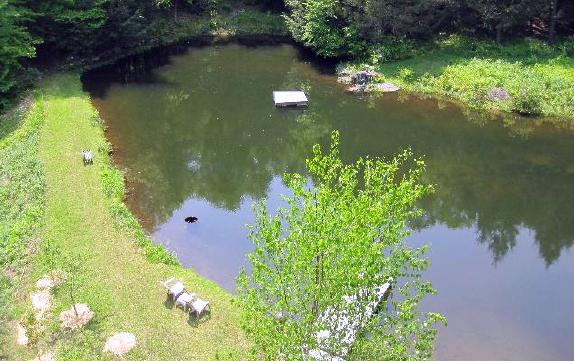 My thanks to Phyllis and Peter for helping me to make this entry accurate, and for supplying all the photos. Any further stories of the pond are for them to tell, not me. Since in 1986 we did all our calculations in English system units, in this blog entry I've reversed my usual convention of giving metric units first. Where it's mentioned, a "gallon" is an American gallon (3.785 liters), not an Imperial gallon (4.546 liters). The fact is, after all these years, neither Peter nor I can recall the actual measurements we obtained at the time. Just for illustrative purposes, I'll work through some plausible values, to illustrate the calculation we did. Suppose that measuring the input to the pond, it took about 9 seconds to fill the 5 gallon (0.67 cubic feet) bucket. Then at the outflow pipe, it would have taken only about 6 seconds to fill the bucket. I do seem to recall that the measurement of these short times with an ordinary watch was one of the inaccuracies of our calculation, but then again, the entire exercise was pretty approximate. I think the flakiest number we used was our six-foot estimate of the average depth of the pond. Filling the bucket in 6 seconds gave us an outflow rate of 0.67 / 6 = 0.112 cubic feet per second (about 0.84 gallons per second, 3.17 liters per second). This gave us an estimate of the inflow to the pond from all sources - the stream providing 2/3 of the water, and the other 1/3 coming from seepage from the ground water at multiple locations. With an estimated area of about 12,500 square feet, and an estimated average depth of 6 feet, we were estimating the volume of the pond to be 75,000 cubic feet. So at a rate of 0.112 cubic feet per second, we estimated that once the outflow valve was closed, the pond would fill in 75,000 / 0.112 seconds = 669,643 seconds. Since there are 60 X 60 X 24 = 86,400 seconds in a day, that represents 7.75 days, or a bit over a week. I don't recall how close we came to the actual value. Of course, the flow of the stream is not at all regular. As Peter noted above, it can sometimes even dry up entirely. But then, if there are heavy rains, it can become quite a torrent.
  |

 Peter purchased some brook and rainbow trout that were "catching" size - anywhere from 8" to 10" (20 - 25 cm), at about $2.50 per fish, and poured them into the pond. This caused an Osprey to show up. It camped in a tree overlooking the pond, and periodically swooped down to snag a trout right out of the water with its talons, eating quite a few of the fish. It departed before taking them all, but those the osprey didn't eat were eventually finished off by otters, one of which is shown to the left, swimming in the pond. Peter noted, "As much as we like otters, feeding them can get expensive." So they haven't re-stocked the pond with additional fish.
Peter purchased some brook and rainbow trout that were "catching" size - anywhere from 8" to 10" (20 - 25 cm), at about $2.50 per fish, and poured them into the pond. This caused an Osprey to show up. It camped in a tree overlooking the pond, and periodically swooped down to snag a trout right out of the water with its talons, eating quite a few of the fish. It departed before taking them all, but those the osprey didn't eat were eventually finished off by otters, one of which is shown to the left, swimming in the pond. Peter noted, "As much as we like otters, feeding them can get expensive." So they haven't re-stocked the pond with additional fish.